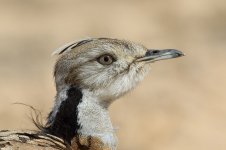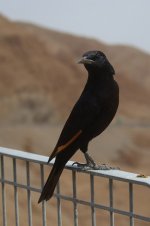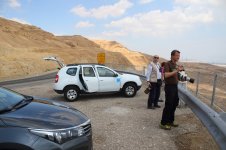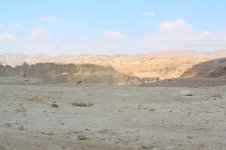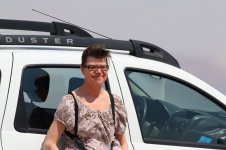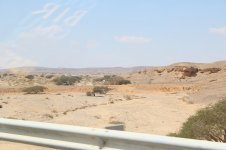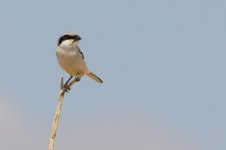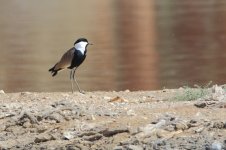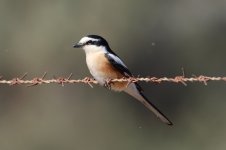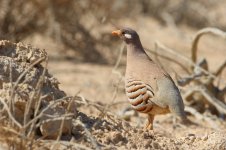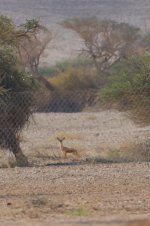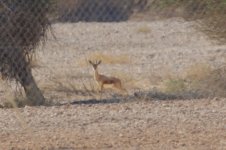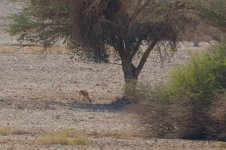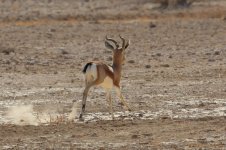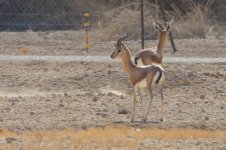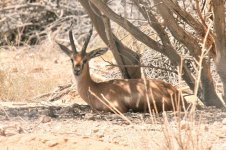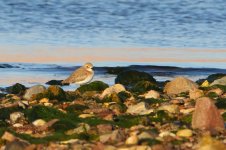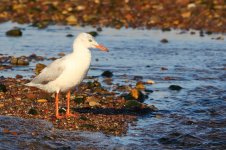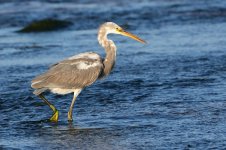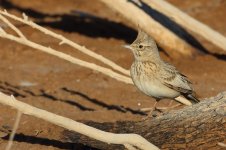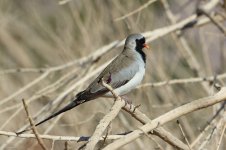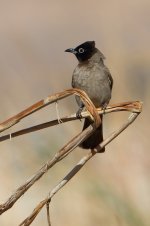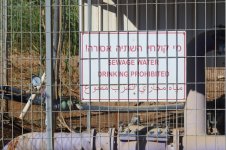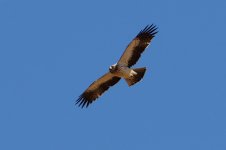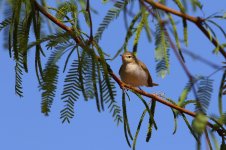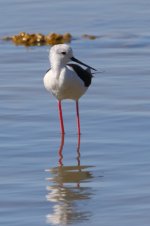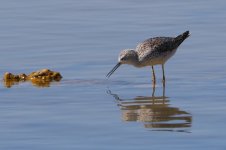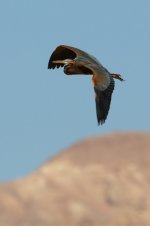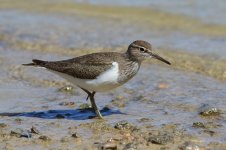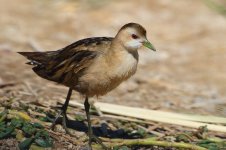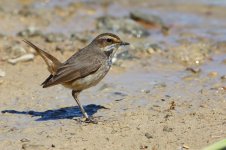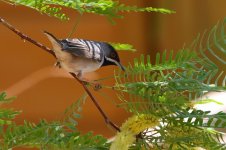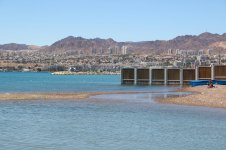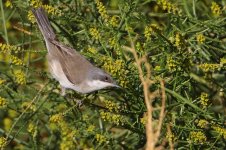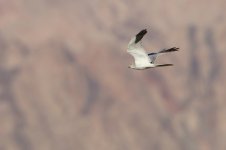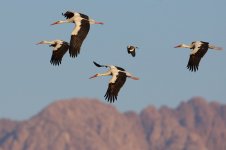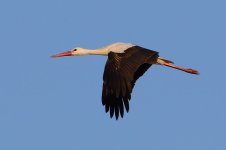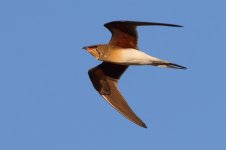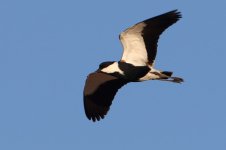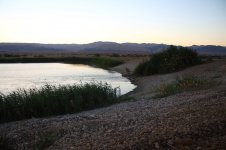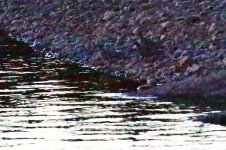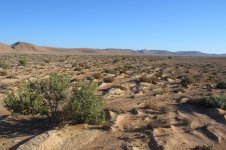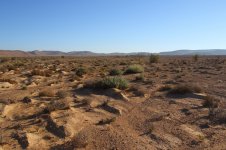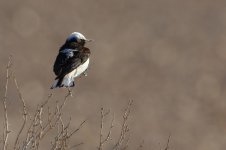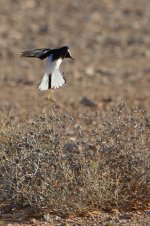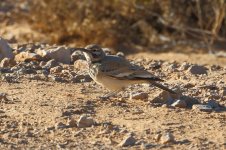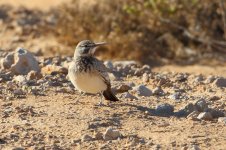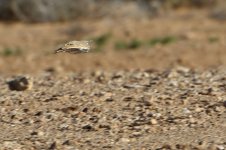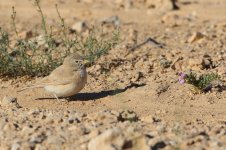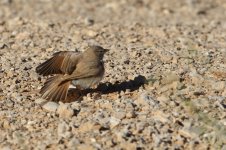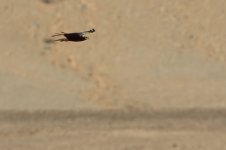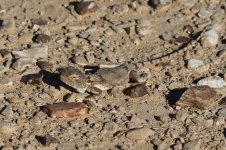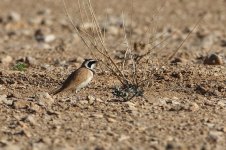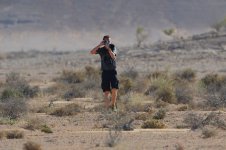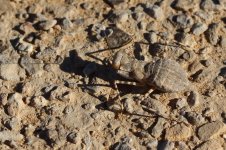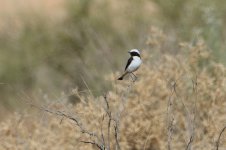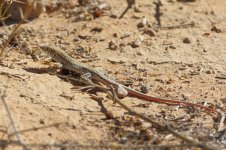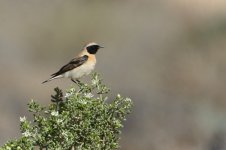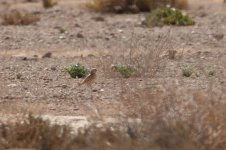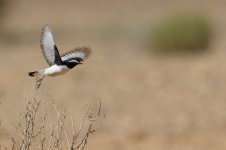3 April: Monday 1
Foreign tripping is the art of the possible and after a long drive yesterday a fiendishly early start was right out. Notwithstanding this I woke fairly early and had a scan round the hotel area, finding little of interest apart from the first of many Eastern Bonelli's Warblers for the day in a tree overhanging the courtyard and the inevitable bulbuls and House Crows on telegraph wires and posts.
Our first birding destination once mobile was the North Beach, after which we intended to bird our way up to the International Birdwatching and Research Centre Eilat (IRBCE or the Eilat Birdwatching Centre, I do not subscribe to New World spelling.) A small stream runs into the Red Sea (Gulf of Aqaba) there and this attracts waterbirds. Two Western Reef Herons were feeding in the stream mouth and a single Greater Sand Plover roosting on the far side of the spit across the stream from us. Discussion on the identity of the latter was brief - it was a substantial plover with pale legs and a honker of a bill.
A flock of about twenty Slender-billed Gulls was milling about on the sea just off the end of the stream, mostly first-summers but with one or two full adults also present. Of large gulls the cupboard was bare. Loitering a while only added a passing Sandwich Tern, and we set off inland along a baked earth track, stopping occasionally to reconnoitre. More EBWs and Lesser Whitethroats resulted, but we also had nice close views of a couple of Crested Larks as well as a brief Wryneck, a cracking male Namaqua Dove and numbers of Laughing and Collared Doves before reaching the IRBCE.
We also had an encounter with a date palm harvesting platform, a conventional cherry-picker except for a platform that spilt, then clamped around the tree allowing access to the full circumference. It was doing the outside palms of a plantation from our track and we had to sidestep it via a ramp up to another track. As it couldn't reach any distance into the locked up plantation we speculated that it was date rustlers. The plantations seemed to be devoid of birds: we were later assured that they would be "dripping with flycatchers and stuff" but oddly we never managed to confirm this.
Arriving at the centre we parked by the half dozen other cars (really? Pennington would be more crowded and this is the legendary Eilat!) and walked in, to be roundly ignored by the staff of this free resource. As you come through the gate you are under a canopy of tamarisk and other trees. To your left front are salt pans, straight ahead is a track and front right appears to be impenetrable bush. Of course it isn't: there are tracks through, some to ringing stations, one that joins up with the main drag for a birder circuit leading past two hides overlooking a great scrape (one the open water and the other, a small reedbed overhung by trees: very good for close crakes.) At the far end of the circuit is the raptor migration station but this can't offer very good views of birds tracking along the mountains at the West side of the city: good enough with a scope to ID and count but not much more.
We started with the immediate area where a male Ruppell's Warbler was bouncing about in the lower branches of a tree by the water and then went for a wander along the salt pans, where a couple of dozen Greater Flamingoes were swishing their upside-down heads back and forth and numerous shorebirds scuttled along the water margins after invertebrates. There were Black-winged Stilts, Ruffs and delightful chequered Marsh Sandpipers (its a long time since I saw one in Britain, they seem to have dried up a bit) as well as list fodder like Ringed and Little Ringed Plovers, Dunlin and Little Stints.
Steppe Buzzards were passing through overhead, another staple species of our time in Eilat, and then we were treated to a change in the shape of a pale morph Booted Eagle that gave us great views as it circled up above us in the bright blue sky. Reaching the open water scrape hide we settled down and enjoyed flypasts from Squacco and Black-crowned Night Herons, a full-blown flying display from a dozen Purple Herons, then first brief and then point-blank extended views of Little Crakes, a Bluethroat that had been maintaining a territory for several days, a Sedge Warbler that chose to hop about on open sand at the water's edge instead of skulking in bushes. Needless to say cameras were active.
We also picked up a few Hirundines, with Red-rumped Swallows, Swallows and the odd Rock Martin and Sand Martin all passing over but not generally hanging about or being photographable.
We returned to the hotel for a siesta in the hottest part of the day, which was somewhere in the mid-thirties Celsius. I can't quite remember whether it was en route to the hotel or after we left it again, but we nipped round to Dolphin Reef where we had been told an adult White-eyed Gull was hanging out regularly on the barriers that keep the captive Bottlenoses in. We got the gull (and brief views of the dolphins) from a pay car park we didn't hang about at. Distant: but we hoped to do better at North Beach later in the week.
After that we headed North out of town to seek out the Km 19 sewage pools ready for an evening stakeout for Lichtenstein's Sandgrouse. We had a little trouble with the directions, chiefly our own inability to recognise a modern treatment works, and did some birding at a small wadi about a Km too far South having bypassed the actual site. This was a happy accident as it was full of birds (mostly Lesser Whitethroats of course) including Eastern Orphean Warbler that proved too active and elusive from my lens and Eastern Olivaceous Warbler that didn't. A yell alerted the whole team to a male Pallid Harrier that really shot through, must have been on a promise when he got to his territory up North, but I managed to get a few shots off anyway and it was my candidate for Bird of the Day.
When we did find the Km 19 pools, they were great. Yellow Wagtails of various appearances were flocking in to feed and roost by hundreds. Spur-winged Plovers were numerous, and a flock of about a hundred White Storks came up and circled before continuing North a little to our East, beautifully lit by the evening sun behind us and against the backdrop of the Jordanian mountains. Fabulous. A couple of Collared Pratincoles gave us a close series of flybys. Squacco Herons popped in and out of reedbeds, and a Black-crowned Night Heron near our chosen sitting positions with other birders teased from its reeds before emerging properly after sunset. Cattle and Little Egrets completed the day's heron list as the light faded.
When it was nearly dark, three Lichtenstein's Sandgrouse sneaked down onto the bank of the lake and sat there halfway up from the water, taking a view of the situation before scuttling down the gravel to drink at the edge - and being driven back by an aggressive Spur-winged Plover! They sat and considered further while the plover calmed down, and eventually managed to fulfill their needs without getting beaten up any more. I took some shots at ISO 51,200 which are everything you would expect. I'll post one later.
We dined this evening at a street café much closer to home. We'd actually been trying to follow directions to an Italian restaurant but must have misunderstood them: the street café was cheap, clean, quick and happy for us to get beers from the shop up the road and eat at his one table. It was a good meal and we thought we might well be back another night.
John
Greater Sand Plover
Slender-billed Gull
Western Reef Heron
Crested Lark
Namaqua Dove




